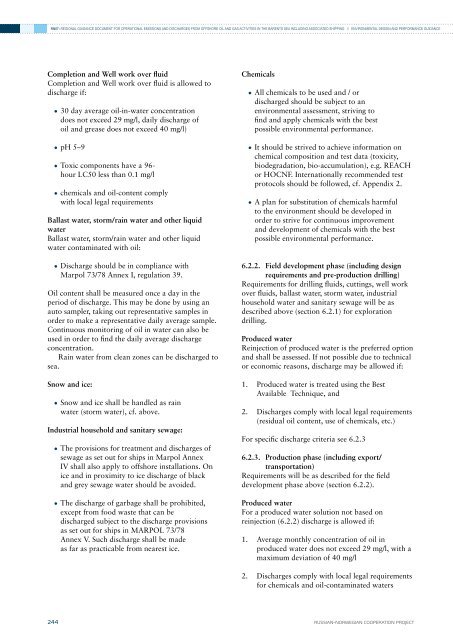phase 4 report - DNV
phase 4 report - DNV
phase 4 report - DNV
Create successful ePaper yourself
Turn your PDF publications into a flip-book with our unique Google optimized e-Paper software.
RN07: REGIONAL GUIDANCE DOCUMENT FOR OPERATIONAL EMISSIONS AND DISCHARGES FROM OFFSHORE OIL AND GAS ACTIVITIES IN THE BARENTS SEA INCLUDING ASSOCIATED SHIPPING // Environmental design and performance guidanceCompletion and Well work over fluidCompletion and Well work over fluid is allowed todischarge if:• 30 day average oil-in-water concentrationdoes not exceed 29 mg/l, daily discharge ofoil and grease does not exceed 40 mg/l)• pH 5–9• Toxic components have a 96-hour LC50 less than 0.1 mg/l• chemicals and oil-content complywith local legal requirementsBallast water, storm/rain water and other liquidwaterBallast water, storm/rain water and other liquidwater contaminated with oil:• Discharge should be in compliance withMarpol 73/78 Annex I, regulation 39.Oil content shall be measured once a day in theperiod of discharge. This may be done by using anauto sampler, taking out representative samples inorder to make a representative daily average sample.Continuous monitoring of oil in water can also beused in order to find the daily average dischargeconcentration.Rain water from clean zones can be discharged tosea.Snow and ice:• Snow and ice shall be handled as rainwater (storm water), cf. above.Industrial household and sanitary sewage:• The provisions for treatment and discharges ofsewage as set out for ships in Marpol AnnexIV shall also apply to offshore installations. Onice and in proximity to ice discharge of blackand grey sewage water should be avoided.• The discharge of garbage shall be prohibited,except from food waste that can bedischarged subject to the discharge provisionsas set out for ships in MARPOL 73/78Annex V. Such discharge shall be madeas far as practicable from nearest ice.Chemicals• All chemicals to be used and / ordischarged should be subject to anenvironmental assessment, striving tofind and apply chemicals with the bestpossible environmental performance.• It should be strived to achieve information onchemical composition and test data (toxicity,biodegradation, bio-accumulation), e.g. REACHor HOCNF. Internationally recommended testprotocols should be followed, cf. Appendix 2.• A plan for substitution of chemicals harmfulto the environment should be developed inorder to strive for continuous improvementand development of chemicals with the bestpossible environmental performance.6.2.2. Field development <strong>phase</strong> (including designrequirements and pre-production drilling)Requirements for drilling fluids, cuttings, well workover fluids, ballast water, storm water, industrialhousehold water and sanitary sewage will be asdescribed above (section 6.2.1) for explorationdrilling.Produced waterReinjection of produced water is the preferred optionand shall be assessed. If not possible due to technicalor economic reasons, discharge may be allowed if:1. Produced water is treated using the BestAvailable Technique, and2. Discharges comply with local legal requirements(residual oil content, use of chemicals, etc.)For specific discharge criteria see 6.2.36.2.3. Production <strong>phase</strong> (including export/transportation)Requirements will be as described for the fielddevelopment <strong>phase</strong> above (section 6.2.2).Produced waterFor a produced water solution not based onreinjection (6.2.2) discharge is allowed if:1. Average monthly concentration of oil inproduced water does not exceed 29 mg/l, with amaximum deviation of 40 mg/l2. Discharges comply with local legal requirementsfor chemicals and oil-contaminated waters244RUSSIAN–NORWEGIAN COOPERATION PROJECT






![Risk Based Pipeline Integrity Management [Compatibility Mode] - DNV](https://img.yumpu.com/50424229/1/190x146/risk-based-pipeline-integrity-management-compatibility-mode-dnv.jpg?quality=85)









